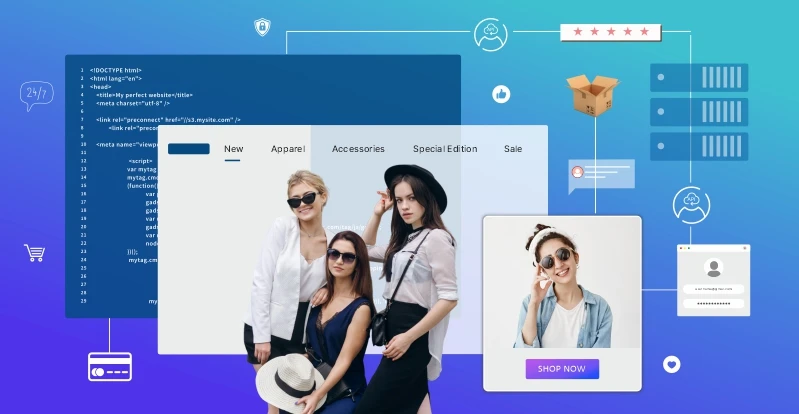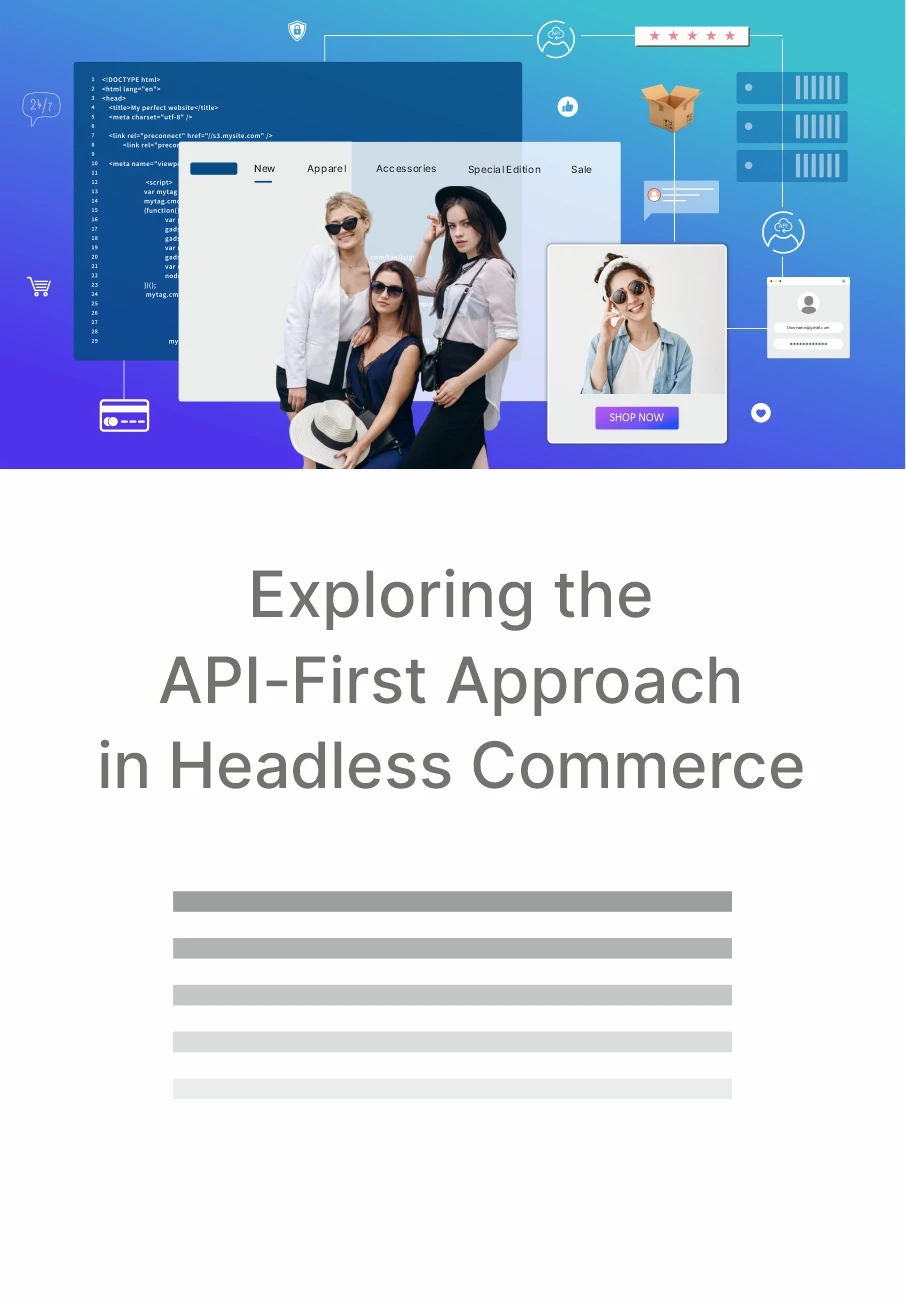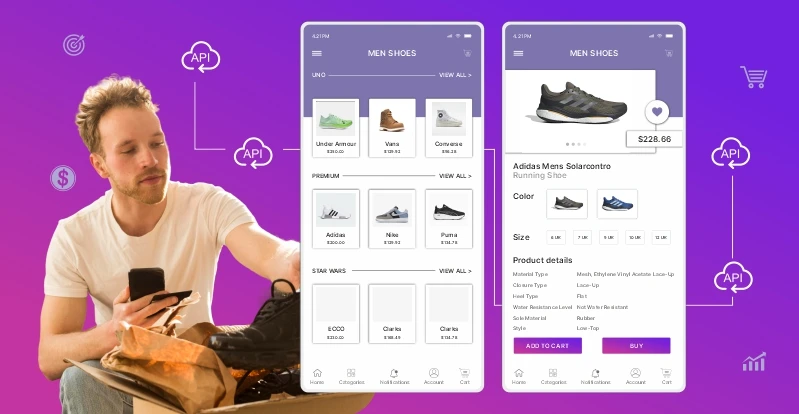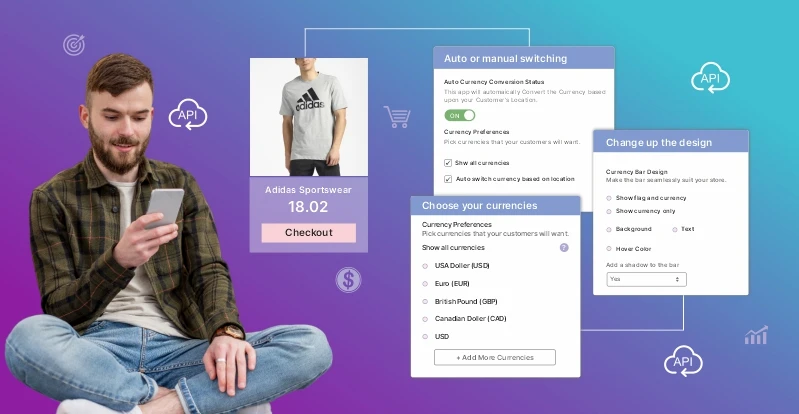Exploring the API-First Approach in Headless Commerce


Get The Print Version
Download a PDF version for easier offline reading and sharing with coworkers
The eCommerce industry’s evolving client demands have led to a greater requirement for smart tools and technologies. In the competitive landscape of eCommerce, one solution that can help improve consumer experience is connecting API-first with your headless commerce.
According to studies, the headless commerce market is now valued at $751.6 million. By 2032, it is projected to increase to $5,528.5 million. API-first can boost customer experience by ensuring higher flexibility in all the channels.
The end-user experience is transformed by API-based headless with the help of these refined solutions. Today, we will explore the key features of API for headless commerce architecture and how it can be helpful in online business. We will also identify the benefits and future trends of the API-based approach for headless eCommerce.
The Role of APIs in Headless Commerce
API-based headless commerce platform has many benefits that can completely change your eCommerce business’s performance. Before that, it’s essential to know the critical role of API for headless commerce.
A headless API is an app that connects to a front-end solution through an API. It works without a visual interface. It doesn’t require a grasp of the back-end implementation. The front end can access data and perform operations using the API’s endpoints.
On the other hand, a headless website keeps its information’s appearance distinct from its storage. This offers benefits like security and flexibility but without omnichannel distribution support. Headless API-first has many other benefits; let’s explore a few of them below:
Flexibility in Front-end Development
API-first allows for more flexible front-end development, leading to faster processing for eCommerce businesses. Unlike monolithic systems that tightly link the front and back ends, headless APIs separate them, allowing for flexibility and innovation.
This allows developers to create personalized user experiences across platforms using various front-end frameworks and back-end technologies. Businesses can select front-end technologies with headless APIs that complement their branding and functional goals. It is possible to swiftly update the user interface without affecting the primary system. This helps the architecture to speed up development.
Improved User Experience
Customer happiness is critical in the eCommerce industry. API-based headless commerce is a crucial element that ensures end users receive a more personalized and improved experience due to its strong personalization capabilities. By satisfying customer demands and adjusting to the online market, businesses can obtain a competitive advantage, boost revenue, and retain clients.
Faster time to Market
Selecting an API-based headless strategy shortens the time needed to launch a product using already-built infrastructure and components. Development processes become more streamlined because APIs are adaptable and simple to expand upon and enhance. Teams can save time and effort by reusing APIs to add new features or launch new products. It eventually helps to reduce the launching time in the market.
Smooth Integration
Smooth integration is critical in the complex world of eCommerce. APIs are essential for seamless processes to navigate intricate tech stacks. Because of their standard interfaces and protocols, developers may integrate systems and applications more efficiently.
This seamless integration improves overall system performance and speeds up the rollout of new features. Businesses may easily synchronize data, workflows, and functionalities using APIs as the bridge between various tech ecosystem components. Businesses can create a flexible infrastructure that can adjust to changing needs in the eCommerce environment.
Custom- Friendly
Businesses can create custom solutions that precisely match their client’s needs. You can implement the API-based approach’s custom ability to perform this process. Flexibility makes integration of these refined technologies that provide the required features and functionalities possible. Companies can easily incorporate AI capabilities and specialized tools into their systems to adjust to the changing needs.
According to research, “86% of buyers claim that customization affects their choice of products.” The technology stack is future-proofed and meets developing trends simultaneously, improving customer satisfaction.
Businesses can remain flexible and adaptable by developing unique solutions and integrating them with various technologies. This allows them to address evolving client requirements effectively and keep up with technological advancements.
How Can You Use a Headless eCommerce API
API-based headless has many benefits for online businesses, but now the question is how it can be helpful for your eCommerce businesses. A few key features that can be used in online business. Let’s explore them below:
Seamlessly Manage Catalog
The core feature of Catalog API is it helps the online business to adapt, build, and manage large product categories swiftly. This smooth process enables fast updates to various catalogs. It can update many products in a short amount of time. Additionally, it does not impact the back-end systems infrastructure.

Furthermore, with the help of API-based headless, the specific category can be extracted from the existing eCommerce system. These customized categories can seamlessly connect to a network with unique product descriptions. This not only simplifies catalog administration but also improves the resilience of eCommerce platforms.
Let’s take an example of a global fashion retailer who can effortlessly synchronize and customize product offerings for diverse markets. It will ensure a dynamic shopping experience across multiple online storefronts.
Simplified Login process
Integrating customer ID capture and administration into eCommerce is crucial for improving the consumer shopping journey. It allows the user to efficiently conduct their eCommerce login securely. One way to do this procedure is by allowing people to sign in with their Google or Facebook accounts. It expedites and improves user experience by streamlining the registration procedure.
Statista says, “73% of online customers would rather use a social media login than a time-consuming registration process”. This not only provides an easy way to log in, but it also fosters confidence and a sense of security.
For example, A jewelry business lets customers use their social media logins to access their platform easily. This makes the onboarding process simple and secure and encourages customer engagement and loyalty.
Manage Cart with Ease
Managing your eCommerce cart is a primary concern for all retailers and brands. With the help of an API-based headless commerce solution, this problem can be easily solved. Developing a robust eCommerce solution will help firms successfully manage their consumers’ shopping carts.
An online grocery store can use this feature to calculate shipping and weight fees in real time for the customer’s location. This feature automatically allows the store to determine the fees based on the customer’s location.
Accuracy and transparency are ensured by the real-time fee calculation provided by the system. Because they don’t have to calculate the costs by hand, this saves time for both the store and the consumer. The feature takes the customer’s location into account to calculate shipping and weight charges more precisely. Decreasing errors and streamlining the checkout process for a better shopping experience raise customer happiness.
Customized Checkout
In today’s eCommerce business, personalization plays an important role. Thus, eCommerce companies can enhance the user experience by tailoring the checkout process for various customers.
Recent data indicates that checkout optimization can boost a 35.62% conversion. For instance, the buyer’s visibility will increase if the brand can show prices depending on the various currencies. This customization lessens confusion during the checkout process while meeting the demands of each audience.
To create a smooth and customized transaction experience, businesses can also give different consumer segments customized payment methods, language options, and delivery alternatives. It may be a great way to more readily engage with various end consumers.

One-stop Marketing Solution
Offering an effective marketing process is a need for every eCommerce business. A helpful marketing process is directly associated with business sales. Therefore, choosing a robust solution for conducting the marketing process is essential.
API-based eCommerce solution helps you organize customers into email lists based on important factors. This will allow businesses to send targeted and relevant email campaigns to customers in specific areas, such as local promotions or exclusive offers to high-value customers.
By utilizing these segmentation skills, online brands can improve communication and give specific consumer groups more helpful material. Helping the user understand the product more effectively will increase customer conversion rates and sales.
Customer-specific Experience
The eCommerce business is an ever-changing industry. To keep up with the pace of this market and customer demand, offering a personalized experience is essential. However, conducting this process through a traditional approach is not possible. Therefore, connecting with a Customer API is necessary.
This helps to enable eCommerce enterprises to provide personalized experiences to the users using their information. Integrating APIs in headless eCommerce allows firms to improve digital customer experience by approaching AI capabilities.
A grocery eCommerce company can use the Customer API to provide personalized suggestions to customers. These suggestions are based on their buying history, food preferences, or location. This approach will increase user engagement and make clients happy, leading to more sales and higher ROI.
Success Stories
API-based headless commerce can offer various solutions for online business. Many leaders have already chosen this approach. Let’s explore a few of them below:
Nike
Nike uses a modern eCommerce method to meet changing consumer needs and technological advancements in sports shoes. They have adapted their small-screen interactions to improve mobile experiences by optimizing graphics and links for mobile browsing.
The API-based method allowed them to customize the mobile interface without back-end constraints. This helped them offer unique products from competitors such as Adidas. Nike’s fast implementation enabled them to quickly adjust to a changing landscape, securing their position as a market leader in online sports and athletic apparel.
Coca-cola
Coca-Cola, the world’s largest beverage brand, offers a seamless multichannel experience to its customers worldwide. This has been possible using a fully integrated, API-enabled headless commerce system. It enables the brand to build unique marketplaces and adapt customer experiences.
Besides, collaboration with third-party providers and solutions has also been possible. It allows them to respond to the changing market situations. It also helps them to Coordinate with emerging consumer demands and remain competitive. By approaching API-enabled headless commerce, Coca-Cola offers a consistent experience to its buyers in a changing marketplace.
Future Trends in API-First Headless Commerce
API-first headless commerce can be a transformer for the online business. This approach is growing and will come up with a great future. We have identified a few future trends; let’s have a look below:
Voice Commerce
With the growing popularity of voice-activated devices, API-first headless commerce will become increasingly crucial for voice commerce. APIs will aid in integrating eCommerce platforms with voice assistants, allowing people to purchase things and interact with brands via natural language commands.
Subscription-based Models
API-first headless commerce is a strong fit for subscription-based models because it allows businesses to segregate the front and back ends, allowing them to alter and extend subscription services simply. This method enables tailored experiences as well as regular revenue streams.
PWAs
Progressive Web Apps (PWAs) have become increasingly popular in mobile. PWAs employ APIs to create speedy and app-like internet experiences, promoting mobile-first initiatives and boosting user interaction.
Mobile-first Strategy
Mobile-optimized strategies are becoming increasingly vital to maximize the company’s customer convenience and sales. It can be done by creating customized and responsive mobile experiences by separating the front-end and back-end. Due to their ascendable eCommerce, companies can meet the growing need for mobile purchasing and brand participation.
Conclusion
API-based headless commerce is quickly gaining traction among eCommerce companies because of its remarkable user experiences and capacity to interface with refined technology.
According to Digital Journal, the global market for headless CMS software was estimated to be worth USD 490.0 million in 2021 and is projected to grow at a CAGR of 20.5% throughout the forecast period, reaching USD 1500.0 million by 2027.
An API-focused architecture helps companies adapt quickly to new trends. This leads to higher revenue, improved client loyalty, and increased customer satisfaction. API-based headless commerce is crucial for companies in online commerce to stay competitive and find innovative solutions.
To ensure a great outcome, it’s essential to connect with experts. Consult with the headless industry professionals to explore better possibilities. Further helpful in making better decisions for the eCommerce business.





